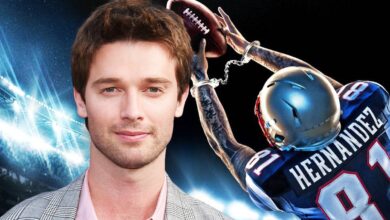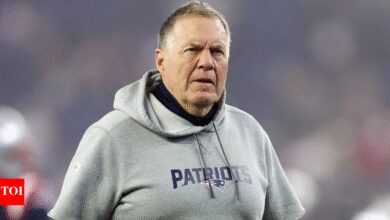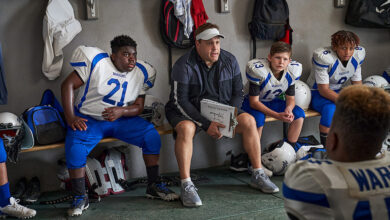Behind the scenes of NFL’s ‘broadcast boot camp’ with Jason Kelce: ‘He’s ready to go’
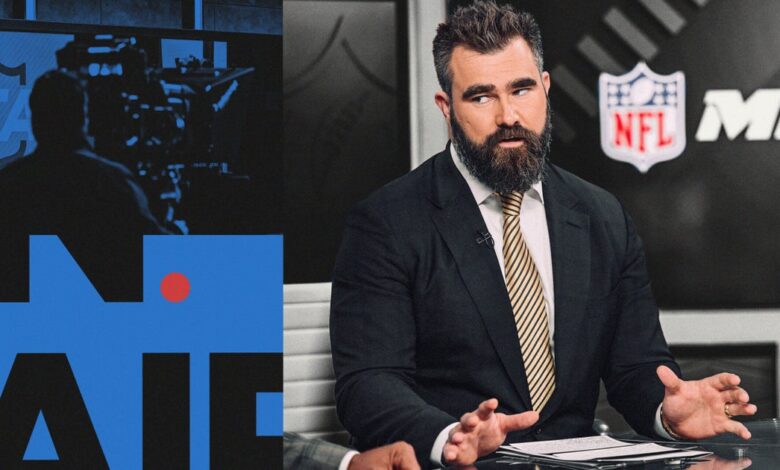
INGLEWOOD, Calif. — “I’m here because I know my time as a player is quickly approaching an end.”
Eight NFL players sat in a conference room at the league offices in the shadows of SoFi Stadium going through a time-tested icebreaker, with each offering something interesting about himself. The seventh player in the room joked about how with three baby girls at home he is surrounded by estrogen, so the locker room offers a testosterone fix. But not for much longer.
“I’m trying to figure out what I want to do and set things up proactively,” Jason Kelce said.
Kelce, entering his 13th season with the Philadelphia Eagles after much deliberation, explained how he’s seen players struggle to find a rhythm in football’s version of civilian life. He talked about his different off-the-field endeavors, from a Christmas album with teammates to a philanthropic foundation supporting Philadelphia schools to cattle ranching.
And then there was the hobby that all the attendees at this year’s NFL’s Broadcasting and Media Workshop — including media executives — knew well and referenced often: the “New Heights” podcast Kelce does alongside his brother, Chiefs All-Pro tight end Travis, which reached No. 1 on Spotify’s sports charts before the Super Bowl.
GO DEEPER
The Kelce brothers and the ‘Heights’ of podcast popularity
Kelce is a five-time All-Pro at center and a likely Hall of Famer. He’s played in two Super Bowls, appeared on “Saturday Night Live” and delivered one of the most memorable championship parade speeches in professional sports. But he approached the week, previously called “Broadcast Boot Camp,” like an undrafted rookie trying to make a roster.
He flew across the country, squeezed into suits and sports coats for three consecutive days, studied rosters and pronunciations from random NFL games and filled index cards with notes and observations. He admitted to nerves ahead of his first trial as a game analyst.
“If I wasn’t nervous, there would be something wrong,” he said.
The Athletic spent parts of three days shadowing Kelce, one of 25 former or active NFL players seeking training and visibility with media executives for a similar reason: every player, no matter status or skill level, eventually becomes a former player.
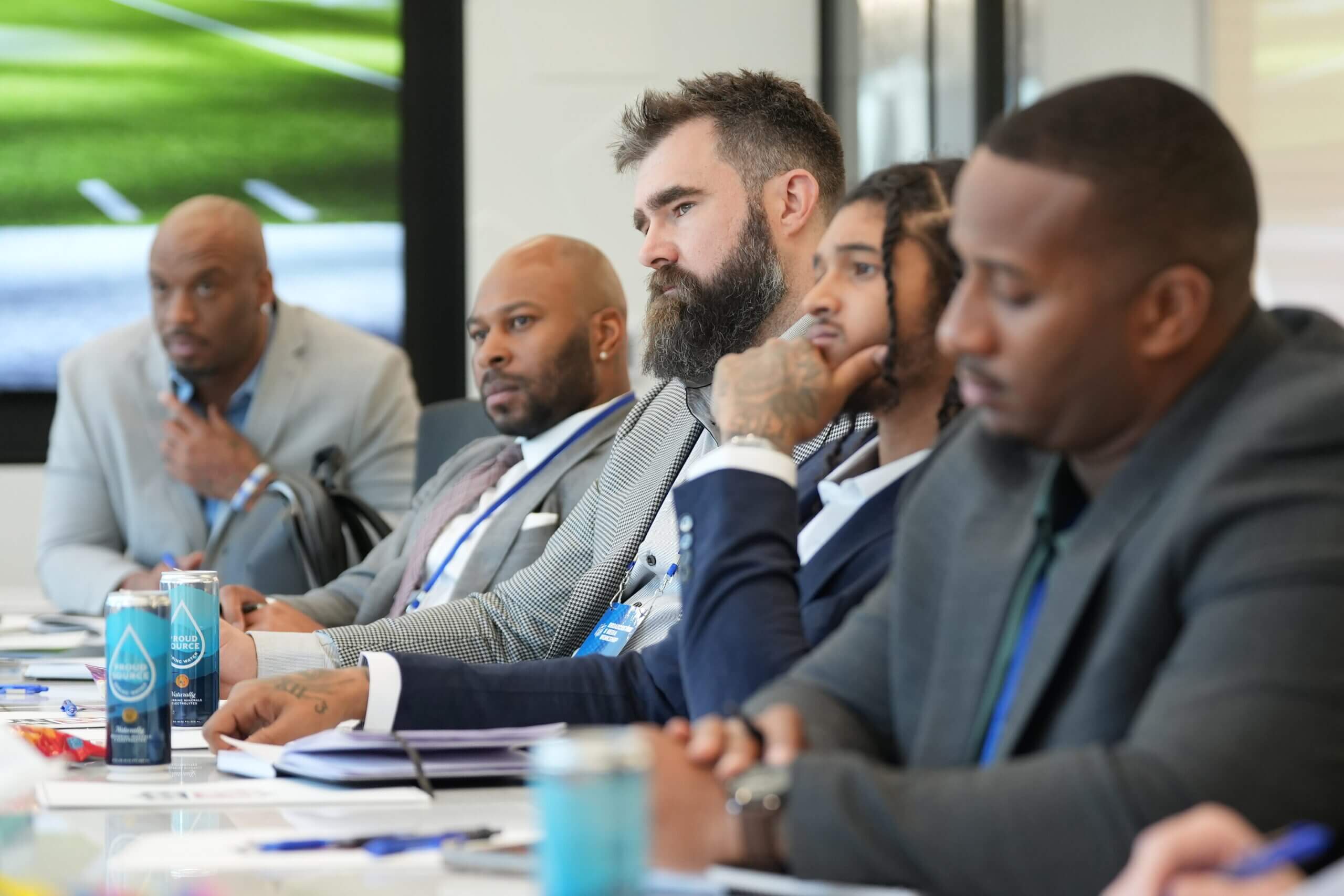
The participants in this year’s NFL Broadcasting and Media Workshop represented a cross-section of current and former players. (Lauren Justice / Associated Press)
Kelce climbed to the back row of the screening room on a Tuesday afternoon last month, grabbing the third seat next to then-Rams wide receiver Allen Robinson, who would be traded to the Steelers two weeks later. The players listened to more than two hours of speakers introducing what was ahead over the next few days.
NFL Network’s Rich Eisen led a panel discussion with analysts Kurt Warner and Michael Robinson about their broadcasting careers. Warner is a Hall of Famer and Super Bowl-winning quarterback, a profile that often opens a lot of doors. Robinson was a fullback and special teams player — and former boot camp participant — who broke through without name recognition.
The workshop, first held in 2007, has undergone different iterations, migrating from NFL Films headquarters in New Jersey to Bowling Green State University to Los Angeles. Over that time it’s become a pipeline for media companies looking for talent. Longtime NFL defensive back Jason McCourty, who turned last year’s boot camp experience into gigs on NFL Network’s “Good Morning Football” show and as a game analyst on Westwood One, described the experience as “invaluable” and “unbelievable.”
“I went out last year not knowing what it was going to be,” McCourty told The Athletic last month. “Honestly, I said to my wife when I signed up to go, ‘We’ll see if I actually have a passion for broadcasting.’ That boot camp was huge for where I am today.”
The league promotes the program starting in November. Players had until Jan. 5 to submit an application explaining why they wanted to attend, along with a corresponding video of on-air work. The league, with the help of broadcast partners, eventually landed on 25 of more than 100 applicants. Those on the waitlist received coaching and can apply again next year.
This year’s group was comprised of 12 offensive players, 12 defensive players and one punter. The participants represented a cross-section of the NFL — a Who’s Who as well as a Who’s That? There were All-Pros like Kelce, Ndamukong Suh and Patrick Peterson, retired standouts like John Abraham, Antoine Bethea and Chris Johnson, and lesser-known players who right now wouldn’t necessarily be viewed as top choices for a broadcast booth. Then again, even non-marquee players can find a place in today’s media landscape — participant Johnny Townsend, a former NFL punter, pointed to the success of fellow punter Pat McAfee.
“I think we were all looking for different perspectives because we all watch so much football and listen to so much football and listen to the podcast and listen to the radio,” said Tracy Perlman, the NFL’s senior vice president of player operations. “You want to hear different things. You want to see different things. And I think that’s what really stood out for us.”
“Name can get a guy in the door, opportunity early on, but it’s those that are really good that are willing to work at it that are going to last,” said McCourty. “You realize when the cameras are rolling and it’s your time to shine, what you did on the football field no longer matters. It’s about how you can sell yourself in front of the camera, how you can articulate whatever you’re trying to say. … Can you make your point, explain it so any viewer sitting at home on the couch can understand it and also be entertained?”
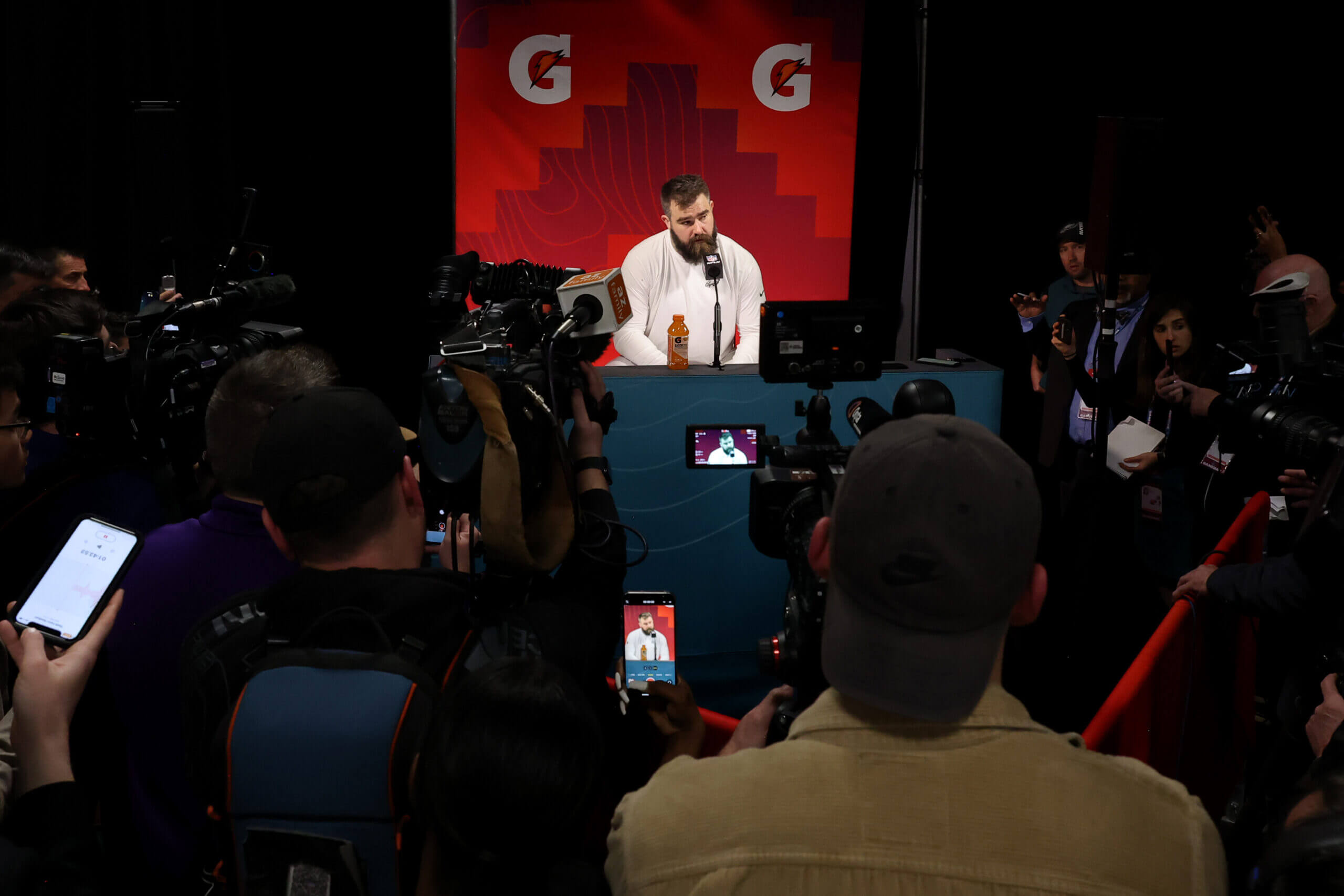
When Jason Kelce is around a microphone, people tend to listen. (Mike Coppola / Getty Images)
On the second day, the players were split into three groups for nearly seven hours of instructional workshops on topics ranging from hosting a radio show to working on a studio desk to social media branding and content creation. Dressed in a checkered sport coat and open-collared shirt, Kelce kept notes and asked questions seeking clarification or different perspectives. The sports radio “topic tree” — finding corresponding topics as a way to discuss a big story — left an impression, and Kelce said he would incorporate the device into his podcast preparation.
The players finished the work day by sitting in on a taping of “NFL Total Access.” Four players were called onto the set as guests (Kelce, Suh, Peterson and Mark Ingram) and appeared on three segments of the show. Kelce discussed his decision to return to the Eagles in 2023 and shared memories of the Super Bowl week and his draft experience. He then played some defense when discussing photos showing him at the hospital for his daughter’s birth, including one in which he ate a hoagie while his wife, then in labor, couldn’t eat.
“A lot of men pass out. The biggest thing is you have to maintain your blood sugar. You have to keep that elevated, otherwise you will pass out!”
The final day, when the players took what they learned and applied theory to practice, was most important. Each participant tried out as a radio and television game analyst, a studio analyst and a podcast co-host, working with national play-by-play and podcast hosts and receiving critiques from producers.
“It’s super smart for both sides,” said Sandy Nunez, the NFL Media’s vice president of talent management. “It allows (players) to see what’s out there when they are ready to retire. And then for us, it allows us to take a look and see and create a pipeline.
“This is so much better than looking at somebody’s reel.”
Kelce couldn’t bottle his excitement. “Ayooo! I know that guy! There he is!”
The problem? Kelce was the analyst for the radio exercise and screamed over the play-by-play announcer while watching his brother score the Chiefs’ game-winning touchdown over the Chargers.
“There we go, baby! A nice shallow crosser, right across the formation. Patrick Mahomes delivers a ball and Travis is able to catch and run all the way to the left pylon. Once you get a step, it’s hard to make up for that. Especially with the long strides of the ‘Big Yeti’ right there, No. 87.”
Kelce was most anxious about how he would perform in these game broadcasts, which he had never done and required a different discipline than on a podcast or even a studio set. Despite the timing issue, he was told this was strong analysis — good insight, apt description and excitement that cannot be taught.
There are additional areas for improvement: Kelce has phrases he uses as crutches and tends to mix in football jargon that casual viewers may not understand. But the enthusiasm is organic, and the football insight was met with high marks from those evaluating him.
“Sometimes people just get it right away, and sometimes people don’t,” said Howard Deneroff, the executive vice president and executive producer of Westwood One’s sports programming. “And there were a couple of things that he said in his commentary that you just don’t get out of people the first time.”
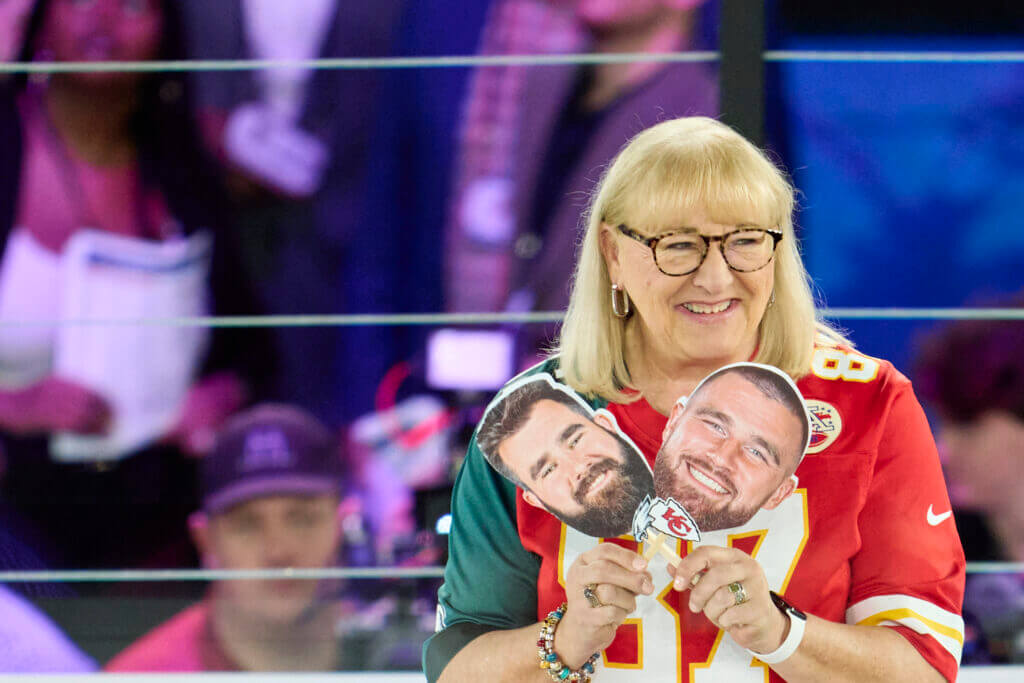
GO DEEPER
Mother’s Day came early for Donna Kelce, who watched her sons in Super Bowl LVII
During the television broadcast of a Vikings–Colts game, Kelce identified why Indy’s defensive line was susceptible to toss plays around the edge. And when Minnesota lost a fumble, Kelce’s insight prompted laughter in the control room: “Never good when Adam Thielen is having to make tackles.” Then, during the replay, Kelce explained why the ball was fumbled with a level of analysis seasoned producers had not heard in decades of broadcasts.
“It’s so hard to maintain ball security as you’re going to the ground. You see this time and time again — when you go to the ground, you want to extend your arms to brace for impact. When you release the point of contact with your chest, it’s very susceptible to this fumble happening.”
When discussing the commentary a few minutes later, Kelce credited Eagles coach Nick Sirianni, saying Philadelphia emphasizes ball-carrying fundamentals “every single day in meetings.” Producers told Kelce that’s exactly what he’s supposed to do in the booth — draw on his experience as a player with a level of expertise that the fan at home doesn’t know.
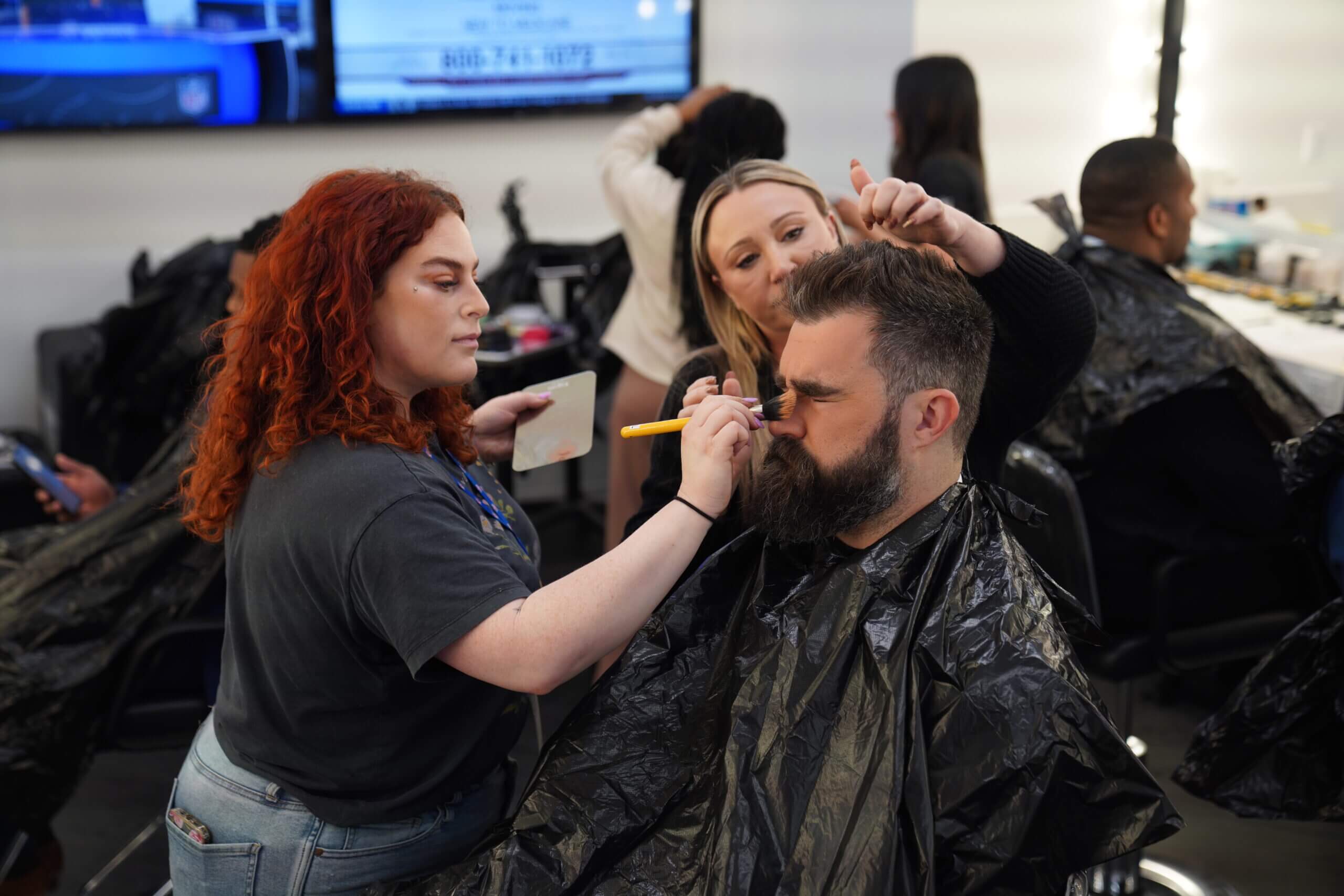
Media executives have already expressed interest in hiring Jason Kelce when he retires. (Lauren Justice / Associated Press)
When Kelce sat down with NFL Media analysts Daniel Jeremiah and Bucky Brooks of the “Move the Sticks” podcast for the podcast portion of the workshop, he proved to be a natural storyteller and conversationalist, bouncing from the nuances of the quarterback sneak to the turf at UConn. Kelce could make you laugh and think in the same sentence and acknowledged this was the part of the day when he was best.
“Literally the advice you give him is, ‘Be you. Just be you,’” said Jeremiah, who was on the Eagles’ scouting staff when they drafted Kelce in 2011 and was recently a guest on Kelce’s podcast. “He’s got such a great personality. He’s got such great experience. And then he’s got, obviously, the pedigree. So at that point in time, it’s like, just don’t screw him up. He’s ready to go.”
Kelce pushes back on the notion that he’s already arrived. He explained how much his podcast is edited and how there are technical parts of the performance he must learn and refine. Plus, Kelce doesn’t want to limit his opportunities.
“This is about more than just having a podcast,” Kelce said. “This is an opportunity to try a bunch of things I haven’t done. Two, I think it’s a way to see how it’s done on the professional side and maybe it’ll make me better at podcasting because I really don’t think I’m that good. I think I’m OK at it.”
Kelce walked on at Cincinnati, was a sixth-round pick in the NFL and didn’t make his first All-Pro team until he was 30. His career has been built upon persistence and the humility required to continue improving. He still remembers a message former Eagles defensive coordinator Jim Schwartz conveyed, that the best players in the league aren’t necessarily the most skilled or the smartest, but the ones who are the most honest with themselves.
“I imagine it’s probably like that kind of across professions,” Kelce said.
His favorite part of the three days was getting coached. He acknowledged there might have been some sugarcoating, but there were also honest notes that he needed to hear. “I like the criticism that’s done in a constructive way,” he said. “I think I respond well to honest feedback.”
Kelce didn’t necessarily need to come to this event. The Jason Kelce business is booming, networks will be contacting him regardless. But the exposure was valuable, and executives interviewed for this story already expressed interest in hiring him when he retires.
“I think I want to do this,” Kelce said. “(Football) is the thing I’ve done the most with my life and it’s the one thing that I’m really truly an expert at. So I think it would be a disservice to step away from that completely. I think however I utilize that — whether it’s coaching high school, coaching in the NFL, doing media — there’s only so many things that you get an opportunity to do to use that expertise once you’re done playing.”
As he said during the icebreaker, he came because he’s trying to figure out what life will look like when it doesn’t include the only full-time job he’s ever known.
(Illustration: Sam Richardson / The Athletic; Photos: Kyusung Gong / Associated Press)
Source link

